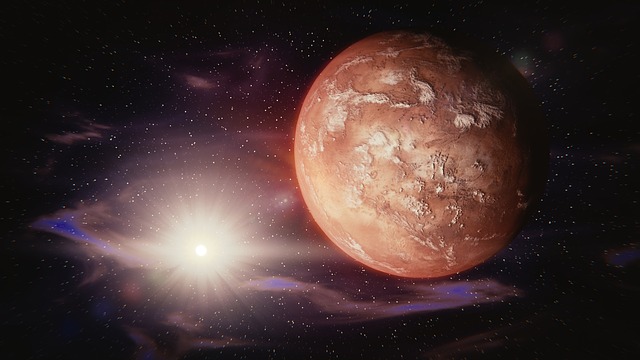Mars
According to distance from the Sun, Mars is the fourth planet. In size it is almost half of our earth. In a favorable state it is bright red, hence it is also called a red planet. Mars is tilted like the Earth on its axis. Its polar regions alternate in front of the sun, from which the heat and winter seasons come in every hemisphere. There is cloud in carbon dioxide in the atmosphere here.
Mars
The fourth planet from the Sun revolves around the Sun- 1 year, 321 days, and elliptical in size.
Chemical ingredient – carbon dioxide (95 percent), 2-3 percent nitrogen, roughly 2 percent argon, some amount of ice climates, ammonia and methane
The tallest mountain volcano in Mars, Nix Olympia
Two satellites in Mars – Phobos and Dmoran
Mariner 9 Mars Planet Space
Asteriod Belt between Mars and Cosmopolitan
See Asteroid (Asteroid).
Many stories have been written about people of Mars and their people, and movies have also been made, but space searches have shown that there is no life of any kind.
From Pictures obtained from Space probe manar 9, it is known that the deep pits on the Mars are dusted valleys and high raised areas. There is more volcanic mountain than Earth. On Mars, about three times the height of Everest is a volcanic mountain Nix Olympia. It is 24 km from the surface of Mars. High raised, 65 km in it There are long huge ice caves.
In 1976 Viking Space Probes (Viking-1 and Viking-2) were sent to Mars, whose purpose was to find out the possibility of life on Mars. But his discoveries showed that there is no life on Mars. The absence of any organism on Mars is not surprising, because the temperature here does not rise above the freezing point. There is no water on Mars. There are two small satellites in Mars – Phobos and Decimos.
Jupiter
Jupiter is the largest planet in the Solar family. Our 318 Earths can be buried in Jupiter. Jupiter is a house made of gases. In this, the characteristics of both stars and planets are found. All planets receive energy from the sun, but Jupiter keeps expanding its radio energy into explosive long web pages. After the sun, the most powerful radio waves in the solar system are the same.
Its air division is mostly hydrogen and helium. Methane and ammonia are also present there. Jupiter’s atmosphere is like our primitive earth. Hydrogen, methane, ammonia and water, which started life on earth, it is possible that even in Jupiter, the same process of life started. It’s gone
The fifth planet from the Sun, orbiting the Sun 11 years 315 days, 1 hour.
Solar System’s largest planet
Jupiter Home has 28 satellites. In which Ganymede, Callisto, Ayo, Europa are prominent. Ganymede is the largest satellite of the solar system.
Jupiter was discovered by the Pioneer Space Campaign for identical red spots.
The largest planet and its velocity velocity is highest (59-64 km / s).
At the end of 1973, the first space probe pioneer reached 10 Jupiter. Their research showed that there is a magnetic field on Jupiter. For the scientists, the waves coming from this magnetic field are still the secret. Scientists believe that life exists on Jupiter somewhere.
In 1979 Voyager-1 and Voyager-II passed through Jupiter. The nearest picture of Jupiter is 18 lakh km from that planet. Drawn from the distance 30 km around the planet Thick rings were also detected. He was aware of the presence of elements like volcanoes and sulfur and oxygen on a satellite iyo. Another satellite of Jupiter Europa, which is shaped by our moon, is covered with snow. At some places the surface of the snow is 100 km Is up to thick
Jupiter is always surrounded by clouds. There are 5 bright strips and four thick striped strips around the planet. There is an odd mysterious red spot on the planet. It is three times bigger than the Earth in size. This is an endless hurricane, which is the permanent part of the planet. It is 40,000 km of Jupiter Long and 4000 km The wide area is covered.
